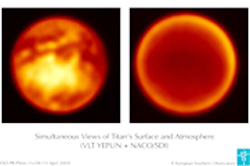This area deals with the fundamental laws and building blocks of nature and how they interact, the properties and the behavior of matter, and research into space and time and their structures.
innovations-report provides in-depth reports and articles on subjects such as astrophysics, laser technologies, nuclear, quantum, particle and solid-state physics, nanotechnologies, planetary research and findings (Mars, Venus) and developments related to the Hubble Telescope.

Discovery overturns 20 years of previous research
Canada’s first space telescope, celebrates its first birthday today, but its latest surprising results could spoil the party for other astronomers whose earlier results are now being questioned.
The MOST team used their tiny but powerful satellite as a stellar stethoscope to take the pulse of one of the best-known stars in the Galaxy, called Procyon (PRO-see-yon), and were shocked to discover their cosmic patient is a “fl

The NASA/ESA/ASI Cassini-Huygens spacecraft is due to arrive at Saturn on 1 July 2004.
This will mark the end of the spacecraft’s journey through the Solar System as well as the beginning of its tour of Saturn, its rings, moons and magnetosphere. The spacecraft will approach Saturn from below the ring plane, and will cross through the large gap between the F Ring and G Ring. The spacecraft’s main engine will fire (or ‘burn’) shortly after passing through the rings to slow Cassini-H

The answer to this fascinating question may be found on Titan, Saturn’s largest moon. University of Southampton scientist Professor Tim Leighton has speculated how the sound of splashing liquid in deep space might differ to that heard on Earth – and it’s possible that his theory could be proved later this year by NASA’s Cassini mission to Saturn. In the meantime, he has recreated the sound he believes it makes and put it on the Internet.
On Thursday 1 July 2004, NASA’s Cassini space craft w

Orion the Hunter is perhaps the best-known constellation in the sky, well placed in the winter for observers in both the northern and southern hemispheres, and instantly recognisable. Just below Orion’s belt (three distinctive stars in a row), the hilt of his sword holds a great jewel in the sky, the beautiful Orion Nebula. Bright enough to be seen with the naked eye, the nebula, also known as Messier 42, is a wide complex of gas and dust, illuminated by several massive and hot stars at its core

Scientists have long doubted that Phoebe came from the same disk of material that formed Saturn and most of its moons. Phoebe has an unusual orbit that is inclined to Saturn’s equator, revolves backward with respect to both Saturn’s rotation and orbital motion, and travels in the opposite direction of Saturn’s other satellites.
Phoebe is widely believed to have wandered past Saturn and been captured by that planet’s mighty gravitational field. Where it wandered from was the question.

A University of Arizona astronomer and his collaborators are using a novel camera to hunt for extrasolar planets.
The project is being funded over the next five years by a $545,000 National Science Foundation award. NSF awarded the highly competitive Faculty Early Career Development (CAREER) grant to Associate Professor Laird M. Close. The CAREER program is a foundation-wide activity that offers the NSF’s most prestigious awards for new faculty members. The CAREER program recognizes